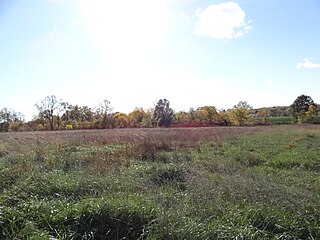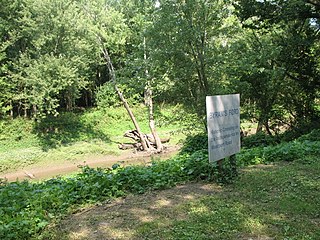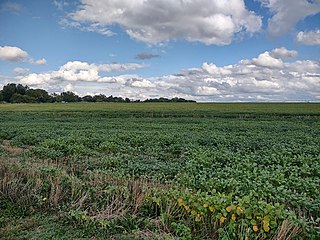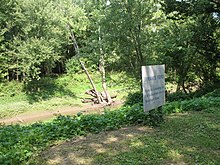
The Battle of Marais des Cygnes took place on October 25, 1864, in Linn County, Kansas, during Price's Missouri Campaign during the American Civil War. It is also known as the Battle of Trading Post. In late 1864, Confederate Major-General Sterling Price invaded the state of Missouri with a cavalry force, attempting to draw Union troops away from the primary theaters of fighting further east. After several victories early in the campaign, Price's Confederate troops were defeated at the Battle of Westport on October 23 near Kansas City, Missouri. The Confederates then withdrew into Kansas, camping along the banks of the Marais des Cygnes River on the night of October 24. Union cavalry pursuers under Brigadier General John B. Sanborn skirmished with Price's rearguard that night, but disengaged without participating in heavy combat.

The Battle of Mine Creek, also known as the Battle of Little Osage, was fought on October 25, 1864, in Linn County, Kansas, as part of Price's Missouri Campaign during the American Civil War. Major-General Sterling Price had begun an expedition in September 1864 to restore Confederate control of Missouri. After being defeated at Westport near Kansas City on October 23, Price's army began to retreat south through Kansas. Early on October 25, Price's army was defeated at the Marais des Cygnes. After Marais des Cygnes, the Confederates fell back, but were stalled at the crossing of Mine Creek while a wagon train attempted to cross.
The Army of the Border was a Union army during the American Civil War. It was created from units in the Department of Kansas to oppose Sterling Price's Raid in 1864. Samuel R. Curtis was in command of the army throughout its duration.

The Second Battle of Independence was fought on October 22, 1864, near Independence, Missouri, as part of Price's Raid during the American Civil War. In late 1864, Major General Sterling Price of the Confederate States Army led a cavalry force into the state of Missouri, hoping to create a popular uprising against Union control, draw Union Army troops from more important areas, and influence the 1864 United States presidential election.
The Second Battle of Lexington was a minor battle fought during Price's Raid as part of the American Civil War. Hoping to draw Union Army forces away from more important theaters of combat and potentially affect the outcome of the 1864 United States presidential election, Sterling Price, a major general in the Confederate States Army, led an offensive into the state of Missouri on September 19, 1864. After a botched attack at the Battle of Pilot Knob, the strength of the Union defenses at Jefferson City led Price to abandon the main goals of his campaign.

The Battle of Little Blue River was fought on October 21, 1864, as part of Price's Raid during the American Civil War. Major General Sterling Price of the Confederate States Army led an army into Missouri in September 1864 with hopes of challenging Union control of the state. During the early stages of the campaign, Price abandoned his plan to capture St. Louis and later his secondary target of Jefferson City. The Confederates then began moving westwards, brushing aside Major General James G. Blunt's Union force in the Second Battle of Lexington on October 19. Two days later, Blunt left part of his command under the authority of Colonel Thomas Moonlight to hold the crossing of the Little Blue River, while the rest of his force fell back to Independence. On the morning of October 21, Confederate troops attacked Moonlight's line, and parts of Brigadier General John B. Clark Jr.'s brigade forced their way across the river. A series of attacks and counterattacks ensued, neither side gaining a significant advantage.

The Battle of Marmiton River, also known as Shiloh Creek or Charlot's Farm, occurred on October 25, 1864, in Vernon County, Missouri during the American Civil War. Major General Sterling Price of the Confederate States Army commenced an expedition into Missouri in September 1864, with hopes of challenging Union control of the state. After a defeat at the Battle of Westport on October 23, Price began to retreat south, and suffered a serious defeat at the Battle of Mine Creek early on October 25. The afternoon of the 25th, Price's wagon train became stalled at the crossing of the Marmaton River in western Missouri. A delaying force led by Brigadier General Joseph O. Shelby attempted to hold off Union cavalry commanded by Brigadier General John McNeil and Lieutenant Colonel Frederick W. Benteen. Shelby was unable to drive off the Union force, although fatigue of the Union cavalry's horses prevented close-quarters action. At nightfall, the Confederates disengaged and destroyed much of their wagon train. Price was again defeated on October 28 at the Second Battle of Newtonia, and the Confederate retreat continued until the survivors reached Texas in early December.

The Battle of Byram's Ford was fought on October 22 and 23, 1864, in Missouri during Price's Raid, a campaign of the American Civil War. With the Confederate States of America collapsing, Major General Sterling Price of the Confederate States Army conducted an invasion of the state of Missouri in late 1864. Union forces led Price to abandon goals of capturing the cities of St. Louis and Jefferson City, and he turned west with his army towards Kansas City.

The Second Battle of Newtonia was fought on October 28, 1864, near Newtonia, Missouri, between cavalry commanded by Major General James G. Blunt of the Union Army and Brigadier General Joseph O. Shelby's rear guard of the Confederate Army of Missouri. In September 1864, Confederate Major General Sterling Price had entered the state of Missouri with hopes of creating a popular uprising against Union control of the state. A defeat at the Battle of Pilot Knob in late September and the strength of Union positions at Jefferson City led Price to abandon the main objectives of the campaign; instead he moved his force west towards Kansas City, where it was badly defeated at the Battle of Westport by Major General Samuel R. Curtis on October 23. Following a set of three defeats on October 25, Price's army halted to rest near Newtonia on October 28.

Price's Missouri Expedition, also known as Price's Raid or Price's Missouri Raid, was an unsuccessful Confederate cavalry raid through Arkansas, Missouri, and Kansas in the Trans-Mississippi Theater of the American Civil War. Led by Confederate Major General Sterling Price, the campaign aimed to recapture Missouri and renew the Confederate initiative in the larger conflict.

The Army of Missouri was a Confederate field army during the American Civil War that served as part of the Trans-Mississippi Department. It was established in September 1864 under the command of Major General Sterling Price to invade Missouri. The fall campaign was unsuccessful, and the army retreated to Arkansas, where it was broken up and reabsorbed into the Army of the Trans-Mississippi.
James Hobart Ford was a Union colonel and brevet brigadier general during the American Civil War, notable for his contributions in the Trans-Mississippi Theater of the war.
The following Union Army units and commanders fought in the Battle of Westport of the American Civil War. The Confederate order of battle is listed separately.
Of the brigades listed below, only Philips' and Benteen's brigades, and a small part of Sanborn's brigade from the Union Army of the Border fought in the Battle of Mine Creek of the American Civil War. The Confederate order of battle is listed separately. The entire organization of the Army of the Border is shown.

Charles White Blair was a lawyer, and Union Army officer who served in three different regiments during the American Civil War. He fought primarily in the Trans-Mississippi Theater and was notable during Price's Missouri Raid.
The 44th Arkansas Infantry (Mounted) (1864–1865) was a Confederate Army Mounted Infantry regiment during the American Civil War. While authorized by the State Military Board as an infantry regiment, the unit was mounted for Price's Missouri Expedition and was officially designated as mounted infantry, but this designation was almost never used by the unit. When a numerical designation is used, the unit is sometimes referred to as the 29th Arkansas Cavalry Regiment. The unit is most often referred as McGehee's Arkansas Cavalry Regiment for its commander, James H. McGehee. McGehee is often spelled McGhee in the Official Records of the Union and Confederate Armies.
Slayback's Missouri Cavalry Regiment was a cavalry regiment of the Confederate States Army during the American Civil War. Originally formed as Slayback's Missouri Cavalry Battalion, the unit consisted of men recruited in Missouri by Lieutenant Colonel Alonzo W. Slayback during Price's Raid in 1864. The battalion's first action was at the Battle of Pilot Knob on September 27; it later participated in actions at Sedalia, Lexington, and the Little Blue River. In October, the unit was used to find an alternate river crossing during the Battle of the Big Blue River. Later that month, Slayback's unit saw action at the battles of Westport, Marmiton River, and Second Newtonia. The battalion was briefly furloughed in Arkansas before rejoining Major General Sterling Price in Texas in December. Probably around February 1865, the battalion reached official regimental strength after more recruits joined.
The capture of Sedalia occurred during the American Civil War when a Confederate force captured the Union garrison of Sedalia, Missouri, on October 15, 1864. Confederate Major General Sterling Price, who was a former Governor of Missouri and had commanded the Missouri State Guard in the early days of the war, had launched an invasion into the state of Missouri on August 29. He hoped to distract the Union from more important areas and cause a popular uprising against Union control of the state. Price had to abandon his goal of capturing St. Louis after a bloody repulse at the Battle of Fort Davidson and moved into the pro-Confederate region of Little Dixie in central Missouri.
Nichols's Missouri Cavalry Regiment served in the Confederate States Army during the late stages of the American Civil War. The cavalry regiment began recruiting in early 1864 under Colonel Sidney D. Jackman, who had previously raised a unit that later became the 16th Missouri Infantry Regiment. The regiment officially formed on June 22 and operated against the Memphis and Little Rock Railroad through August. After joining Major General Sterling Price's command, the unit participated in Price's Raid, an attempt to create a popular uprising against Union control of Missouri and draw Union troops away from more important theaters of the war. During the raid, while under the command of Lieutenant Colonel Charles H. Nichols, the regiment was part of an unsuccessful pursuit of Union troops who were retreating after the Battle of Fort Davidson in late September.
The 13th Missouri Cavalry Regiment was a cavalry unit that served in the Confederate States Army during the American Civil War. In early April 1863, Captain Robert C. Wood, aide-de-camp to Confederate Major General Sterling Price, was detached to form an artillery unit from some of the men of Price's escort. Wood continued recruiting for the unit, which was armed with four Williams guns, and grew to 275 men by the end of September. The next month, the unit fought in the Battle of Pine Bluff, driving back Union Army troops into a barricaded defensive position, from which the Union soldiers could not be dislodged. By November, the unit, which was known as Wood's Missouri Cavalry Battalion, had grown to 400 men but no longer had the Williams guns. In April 1864, Wood's battalion, which was also known as the 14th Missouri Cavalry Battalion, played a minor role in the defeat of a Union foraging party in the Battle of Poison Spring, before spending the summer of 1864 at Princeton, Arkansas. In September, the unit joined Price's Raid into the state of Missouri, but their assault during the Battle of Pilot Knob failed to capture Fort Davidson.


















